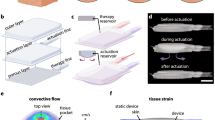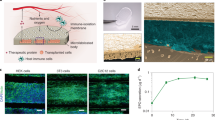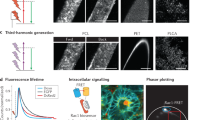Abstract
Implantable medical devices have revolutionized modern medicine. However, immune-mediated foreign body response (FBR) to the materials of these devices can limit their function or even induce failure. Here we describe long-term controlled-release formulations for local anti-inflammatory release through the development of compact, solvent-free crystals. The compact lattice structure of these crystals allows for very slow, surface dissolution and high drug density. These formulations suppress FBR in both rodents and non-human primates for at least 1.3 years and 6 months, respectively. Formulations inhibited fibrosis across multiple implant sites—subcutaneous, intraperitoneal and intramuscular. In particular, incorporation of GW2580, a colony stimulating factor 1 receptor inhibitor, into a range of devices, including human islet microencapsulation systems, electrode-based continuous glucose-sensing monitors and muscle-stimulating devices, inhibits fibrosis, thereby allowing for extended function. We believe that local, long-term controlled release with the crystal formulations described here enhances and extends function in a range of medical devices and provides a generalized solution to the local immune response to implanted biomaterials.
This is a preview of subscription content, access via your institution
Access options
Access Nature and 54 other Nature Portfolio journals
Get Nature+, our best-value online-access subscription
$29.99 / 30 days
cancel any time
Subscribe to this journal
Receive 12 print issues and online access
$259.00 per year
only $21.58 per issue
Buy this article
- Purchase on Springer Link
- Instant access to full article PDF
Prices may be subject to local taxes which are calculated during checkout






Similar content being viewed by others
Data availability
The data supporting the findings of this study are available within the article and its supplementary information files and from the corresponding author upon reasonable request.
References
Fattahi, P., Yang, G., Kim, G. & Abidian, M. R. A review of organic and inorganic biomaterials for neural interfaces. Adv. Mater. 26, 1846–1885 (2014).
Nichols, S. P., Koh, A., Storm, W. L., Shin, J. H. & Schoenfisch, M. H. Biocompatible materials for continuous glucose monitoring devices. Chem. Rev. 113, 2528–2549 (2013).
Rosen, M. R., Robinson, R. B., Brink, P. R. & Cohen, I. S. The road to biological pacing. Nat. Rev. Cardiol. 8, 656–666 (2011).
Farra, R. et al. First-in-human testing of a wirelessly controlled drug delivery microchip. Sci. Transl. Med. 4, 122ra121 (2012).
Hubbell, J. A. & Langer, R. Translating materials design to the clinic. Nat. Mater. 12, 963–966 (2013).
Kearney, C. J. & Mooney, D. J. Macroscale delivery systems for molecular and cellular payloads. Nat. Mater. 12, 1004–1017 (2013).
Yoo, J. W., Irvine, D. J., Discher, D. E. & Mitragotri, S. Bio-inspired, bioengineered and biomimetic drug delivery carriers. Nat. Rev. Drug Discov. 10, 521–535 (2011).
Kenneth Ward, W. A review of the foreign-body response to subcutaneously-implanted devices: the role of macrophages and cytokines in biofouling and fibrosis. J. Diabetes Sci. Technol. 2, 768–777 (2008).
Anderson, J. M., Rodriguez, A. & Chang, D. T. Foreign body reaction to biomaterials. Semin. Immunol. 20, 86–100 (2008).
Doloff, J. C. et al. Colony stimulating factor-1 receptor is a central component of the foreign body response to biomaterial implants in rodents and non-human primates. Nat. Mater. 16, 671–680 (2017).
Vegas, A. J. et al. Combinatorial hydrogel library enables identification of materials that mitigate the foreign body response in primates. Nat. Biotechnol. 34, 345–352 (2016).
Veiseh, O. et al. Size- and shape-dependent foreign body immune response to materials implanted in rodents and non-human primates. Nat. Mater. 14, 643–651 (2015).
Rhen, T. & Cidlowski, J. A. Antiinflammatory action of glucocorticoids—new mechanisms for old drugs. N. Engl. J. Med. 353, 1711–1723 (2005).
Schneider, B. L., Schwenter, F., Pralong, W. F. & Aebischer, P. Prevention of the initial host immuno-inflammatory response determines the long-term survival of encapsulated myoblasts genetically engineered for erythropoietin delivery. Mol. Ther. 7, 506–514 (2003).
Zhang, W. J. et al. HOE 077 reduces fibrotic overgrowth around the barium alginate microcapsules. Transplant. Proc. 32, 206–209 (2000).
Attur, M. G. et al. Differential anti-inflammatory effects of immunosuppressive drugs: cyclosporin, rapamycin and FK-506 on inducible nitric oxide synthase, nitric oxide, cyclooxygenase-2 and PGE 2 production. Inflamm. Res. 49, 20–26 (2000).
Cannarile, M. A. et al. Colony-stimulating factor 1 receptor (CSF1R) inhibitors in cancer therapy. J. Immunother. Cancer 5, 53 (2017).
Wehling, M. Non-steroidal anti-inflammatory drug use in chronic pain conditions with special emphasis on the elderly and patients with relevant comorbidities: management and mitigation of risks and adverse effects. Eur. J. Clin. Pharmacol. 70, 1159–1172 (2014).
Srinivasan, A. & De Cruz, P. Review article: a practical approach to the clinical management of NSAID enteropathy. Scand. J. Gastroenterol. 52, 941–947 (2017).
Lin, J. et al. TNFα blockade in human diseases: an overview of efficacy and safety. Clin. Immunol. 126, 13–30 (2008).
Gyorfi, A. H., Matei, A. E. & Distler, J. H. W. Targeting TGF-β signaling for the treatment of fibrosis. Matrix Biol. 68–69, 8–27 (2018).
Murray, P. J. & Wynn, T. A. Protective and pathogenic functions of macrophage subsets. Nat. Rev. Immunol. 11, 723–737 (2011).
Dang, T. T. et al. Spatiotemporal effects of a controlled-release anti-inflammatory drug on the cellular dynamics of host response. Biomaterials 32, 4464–4470 (2011).
Singarayar, S., Kistler, P. M., De Winter, C. & Mond, H. A comparative study of the action of dexamethasone sodium phosphate and dexamethasone acetate in steroid-eluting pacemaker leads. Pacing Clin. Electrophysiol. 28, 311–315 (2005).
Friedl, K. E. Corticosteroid modulation of tissue responses to implanted sensors. Diabetes Technol. Ther. 6, 898–901 (2004).
Gilligan, B. C. et al. Feasibility of continuous long-term glucose monitoring from a subcutaneous glucose sensor in humans. Diabetes Technol. Ther. 6, 378–386 (2004).
Vacanti, N. M. et al. Localized delivery of dexamethasone from electrospun fibers reduces the foreign body response. Biomacromolecules 13, 3031–3038 (2012).
Weldon, C. B. et al. Electrospun drug-eluting sutures for local anesthesia. J. Control. Release 161, 903–909 (2012).
Ricci, M. et al. Ketoprofen controlled release from composite microcapsules for cell encapsulation: effect on post-transplant acute inflammation. J. Control. Release 107, 395–407 (2005).
Einmahl, S. et al. Concomitant and controlled release of dexamethasone and 5-fluorouracil from poly (ortho ester). Int. J. Pharm. 185, 189–198 (1999).
Siepmann, J., Siegel, R. A. & Rathbone, M. J. (eds) Advances in Delivery Science and Technology (Springer, 2012).
Bain, C. C. et al. Constant replenishment from circulating monocytes maintains the macrophage pool in the intestine of adult mice. Nat. Immunol. 15, 929–937 (2014).
Mosser, D. M. & Edwards, J. P. Exploring the full spectrum of macrophage activation. Nat. Rev. Immunol. 8, 958–969 (2008).
Singh, M. N., Hemant, K. S., Ram, M. & Shivakumar, H. G. Microencapsulation: a promising technique for controlled drug delivery. Res. Pharm. Sci. 5, 65–77 (2010).
Cobelli, N., Scharf, B., Crisi, G. M., Hardin, J. & Santambrogio, L. Mediators of the inflammatory response to joint replacement devices. Nat. Rev. Rheumatol. 7, 600–608 (2011).
Desbois, S., Seabrook, S. A. & Newman, J. Some practical guidelines for UV imaging in the protein crystallization laboratory. Acta Crystallogr. F 69, 201–208 (2013).
Niedzialkowska, E. et al. Protein purification and crystallization artifacts: the tale usually not told. Protein Sci. 25, 720–733 (2016).
Farah, S., Khan, W. & Domb, A. J. Crystalline coating of rapamycin onto a stent: process development and characterization. Int. J. Pharm. 445, 20–28 (2013).
Levy, Y., Khan, W., Farah, S. & Domb, A. J. Surface crystallization of rapamycin on stents using a temperature induced process. Langmuir 28, 6207–6210 (2012).
Puhl, S., Meinel, L. & Germershaus, O. Recent advances in crystalline and amorphous particulate protein formulations for controlled delivery. Asian J. Pharm. Sci. 11, 469–477 (2016).
Yaghmur, A., Rappolt, M., Ostergaard, J., Larsen, C. & Larsen, S. W. Characterization of bupivacaine-loaded formulations based on liquid crystalline phases and microemulsions: the effect of lipid composition. Langmuir 28, 2881–2889 (2012).
Farah, S. Protective layer development for enhancing stability and drug-delivery capabilities of DES surface-crystallized coatings. ACS Appl. Mater. Interfaces 10, 9010–9022 (2018).
Kalepu, S. & Nekkanti, V. Insoluble drug delivery strategies: review of recent advances and business prospects. Acta Pharm. Sin. B 5, 442–453 (2015).
Dang, T. T. et al. Enhanced function of immuno-isolated islets in diabetes therapy by co-encapsulation with an anti-inflammatory drug. Biomaterials 34, 5792–5801 (2013).
Wu, P. & Grainger, D. W. Drug/device combinations for local drug therapies and infection prophylaxis. Biomaterials 27, 2450–2467 (2006).
Murray, P. J. et al. Macrophage activation and polarization: nomenclature and experimental guidelines. Immunity 41, 14–20 (2014).
Chadha, R., Arora, P., Saini, A. & Jain, D. S. Solvated crystalline forms of nevirapine: thermoanalytical and spectroscopic studies. AAPS PharmSciTech 11, 1328–1339 (2010).
Chadha, R., Kuhad, A., Arora, P. & Kishor, S. Characterisation and evaluation of pharmaceutical solvates of Atorvastatin calcium by thermoanalytical and spectroscopic studies. Chem. Cent. J. 6, 114 (2012).
Olafson, K. N., Ketchum, M. A., Rimer, J. D. & Vekilov, P. G. Mechanisms of hematin crystallization and inhibition by the antimalarial drug chloroquine. Proc. Natl Acad. Sci. USA 112, 4946–4951 (2015).
Datta, S. & Grant, D. J. Crystal structures of drugs: advances in determination, prediction and engineering. Nat. Rev. Drug Discov. 3, 42–57 (2004).
Kempster, C. J. E. & Lipson, H. A rapid method for assessing the number of molecules in the unit cell of an organic crystal. Acta Crystallogr. B 28.12, 3674–3674 (1972).
de Groot, M., Schuurs, T. A. & van Schilfgaarde, R. Causes of limited survival of microencapsulated pancreatic islet grafts. J. Surg. Res. 121, 141–150 (2004).
Pepper, A. R. et al. A prevascularized subcutaneous device-less site for islet and cellular transplantation. Nat. Biotechnol. 33, 518–523 (2015).
Simeonovic, C. J., Dhall, D. P., Wilson, J. D. & Lafferty, K. J. A comparative study of transplant sites for endocrine tissue transplantation in the pig. Aust. J. Exp. Biol. Med. Sci. 64, 37–41 (1986).
Georgiev, A. et al. in High Performance Polymers—Polyimides Based: From Chemistry to Applications (ed. Abadie, J. M.) Ch. 4 (Intech, 2012).
SAINT (Bruker AXS, 2011).
Krause, L., Herbst-Irmer, R., Sheldrick, G. M. & Stalke, D. Comparison of silver and molybdenum microfocus X-ray sources for single-crystal structure determination. J. Appl. Crystallogr. 48, 3–10 (2015).
Sheldrick, G. M. SHELXT—integrated space-group and crystal-structure determination. Acta Crystallogr. A 71, 3–8 (2015).
Sheldrick, G. M. Crystal structure refinement with SHELXL. Acta Crystallogr. C 71, 3–8 (2015).
Müller, P. Practical suggestions for better crystal structures. Crystallogr. Rev. 15, 57–83 (2009).
Lacy, P. E. & Kostianovsky, M. Method for the isolation of intact islets of Langerhans from the rat pancreas. Diabetes 16, 35–39 (1967).
Ricordi, C. et al. Islet isolation assessment in man and large animals. Acta Diabetol. Lat. 27, 185–195 (1990).
Bratlie, K. M. et al. Rapid biocompatibility analysis of materials via in vivo fluorescence imaging of mouse models. PLoS ONE 5, e10032 (2010).
Xie, X. et al. Reduction of measurement noise in a continuous glucose monitor by coating the sensor with a zwitterionic polymer. Nat. Biomed. Eng. 2, 894–906 (2018).
Acknowledgements
Work was supported by: JDRF-Juvenile Diabetes Research Foundation Grant 17-2007-1063, National Institutes of Health Grants: DE013023, EB000244, CA151884 and EB000351, Leona M. and Harry B. Helmsley Charitable Trust Foundation Grants: 2015PG-T1D063 and 09PG-T1D027, and through a gift from the Tayebati Family Foundation. J.C.D. was supported by postdoctoral fellowship from JDRF (Fellowship: 3-PDF-2015-91-A-N). J.O. is supported by the Chicago Diabetes Project and the National Institutes of Health (NIH/NIDDK) R01DK091526. G.C.W. is supported by the National Institutes of Health Diabetes Research Centers Grant P30 DK 36836. D.L.G. is supported by the National Institutes of Health (NIH/NIDDK) UC4 DK104218. We acknowledge the use of resources at Core Facilities (Swanson Biotechnology Center, David H. Koch Institute for Integrative Cancer Research at MIT) and W. M. Keck Biological Imaging Facility for Flow Cytometry, Histology, in situ Accelerated Release Microscopy (Wendy C. Salmon, Whitehead Institute), Animal Imaging, and Scanning Electron Microscopy.
Author information
Authors and Affiliations
Contributions
S.F., J.C.D., and D.G.A. designed the studies, analysed data and wrote the paper. S.F., J.C.D., P.M., A.S., H.J.H., K.O., K.V., H.H.T., J.H.-L., P.S.K., M.G., A.M., M.M., A.C.G., J.M. and J.O. conducted the experiments. S.F. and J.C.D. carried out the statistical analyses and prepared displays communicating data sets. G.C.W. and D.L.G. provided advice and technical support throughout. R.L. and D.G.A. supervised the study. All authors discussed the results and the preparation of the paper.
Corresponding author
Ethics declarations
Competing interests
The authors declare no competing interests.
Additional information
Publisher’s note: Springer Nature remains neutral with regard to jurisdictional claims in published maps and institutional affiliations.
Supplementary information
Supplementary Information
Supplementary Figs. 1–21, Supplementary Video captions 1–3, Supplementary Discussions 1–4 and Supplementary references
Supplementary Video 1
In situ monitoring MII and MIII crystals stability and release with fluorescent microscope
Supplementary Video 2
Laparoscopic evaluation and 4-week retrievals of implanted ~0.5 mm capsule without drug in non-human primates
Supplementary Video 3
Laparoscopic evaluation and 4-week retrievals of implanted ~0.5 mm capsule with GW2580 crystals in non-human primates
Rights and permissions
About this article
Cite this article
Farah, S., Doloff, J.C., Müller, P. et al. Long-term implant fibrosis prevention in rodents and non-human primates using crystallized drug formulations. Nat. Mater. 18, 892–904 (2019). https://doi.org/10.1038/s41563-019-0377-5
Received:
Accepted:
Published:
Issue Date:
DOI: https://doi.org/10.1038/s41563-019-0377-5
This article is cited by
-
Clinical translation of wireless soft robotic medical devices
Nature Reviews Bioengineering (2024)
-
Hydrophilic nanofibers with aligned topography modulate macrophage-mediated host responses via the NLRP3 inflammasome
Journal of Nanobiotechnology (2023)
-
Screening hydrogels for antifibrotic properties by implanting cellularly barcoded alginates in mice and a non-human primate
Nature Biomedical Engineering (2023)
-
Immunomodulatory Biomaterials and Emerging Analytical Techniques for Probing the Immune Micro-Environment
Tissue Engineering and Regenerative Medicine (2023)
-
Genetic-code-expanded cell-based therapy for treating diabetes in mice
Nature Chemical Biology (2022)



